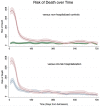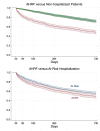Late mortality after acute hypoxic respiratory failure
- PMID: 28780503
- PMCID: PMC5799038
- DOI: 10.1136/thoraxjnl-2017-210109
Late mortality after acute hypoxic respiratory failure
Abstract
Background: Acute hypoxic respiratory failure (AHRF) is associated with significant acute mortality. It is unclear whether later mortality is predominantly driven by pre-existing comorbid disease, the acute inciting event or is the result of AHRF itself.
Methods: Observational cohort study of elderly US Health and Retirement Study (HRS) participants in fee-for-service Medicare (1998-2012). Patients hospitalised with AHRF were matched 1:1 to otherwise similar adults who were not currently hospitalised and separately to patients hospitalised with acute inciting events (pneumonia, non-pulmonary infection, aspiration, trauma, pancreatitis) that may result in AHRF, here termed at-risk hospitalisations. The primary outcome was late mortality-death in the 31 days to 2 years following hospital admission.
Results: Among 15 075 HRS participants, we identified 1268 AHRF and 13 117 at-risk hospitalisations. AHRF hospitalisations were matched to 1157 non-hospitalised adults and 1017 at-risk hospitalisations. Among patients who survived at least 30 days, AHRF was associated with a 24.4% (95%CI 19.9% to 28.9%, p<0.001) absolute increase in late mortality relative to adults not currently hospitalised and a 6.7% (95%CI 1.7% to 11.7%, p=0.01) increase relative to adults hospitalised with acute inciting event(s) alone. At-risk hospitalisation explained 71.2% of the increased odds of late mortality, whereas the development of AHRF itself explained 28.8%. Risk for death was equivalent to at-risk hospitalisation beyond 90 days, but remained elevated for more than 1 year compared with non-hospitalised controls.
Conclusions: In this national sample of older Americans, approximately one in four survivors with AHRF had a late death not explained by pre-AHRF health status. More than 70% of this increased risk was associated with hospitalisation for acute inciting events, while 30% was associated with hypoxemic respiratory failure.
Keywords: Ards; Assisted Ventilation; Clinical Epidemiology; Respiratory Infection.
© Article author(s) (or their employer(s) unless otherwise stated in the text of the article) 2017. All rights reserved. No commercial use is permitted unless otherwise expressly granted.
Conflict of interest statement
Competing interests: None declared.
Figures




References
Grants and funding
LinkOut - more resources
Full Text Sources
Other Literature Sources
